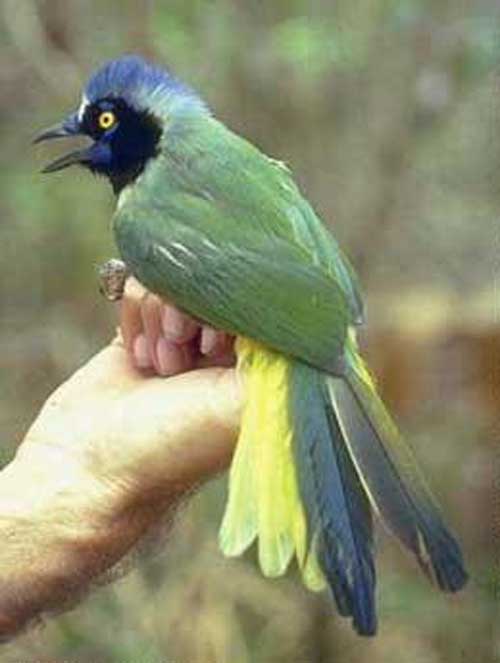
Cyanocorax yncas
Superregnum: Eukaryota
Regnum: Animalia
Subregnum: Eumetazoa
Cladus: Bilateria
Cladus: Nephrozoa
Superphylum: Deuterostomia
Phylum: Chordata
Subphylum: Vertebrata
Infraphylum: Gnathostomata
Megaclassis: Osteichthyes
Cladus: Sarcopterygii
Cladus: Rhipidistia
Cladus: Tetrapodomorpha
Cladus: Eotetrapodiformes
Cladus: Elpistostegalia
Superclassis: Tetrapoda
Cladus: Reptiliomorpha
Cladus: Amniota
Classis: Reptilia
Cladus: Eureptilia
Cladus: Romeriida
Subclassis: Diapsida
Cladus: Sauria
Infraclassis: Archosauromorpha
Cladus: Crurotarsi
Divisio: Archosauria
Cladus: Avemetatarsalia
Cladus: Ornithodira
Subtaxon: Dinosauromorpha
Cladus: Dinosauriformes
Cladus: Dracohors
Cladus: Dinosauria
Ordo: Saurischia
Cladus: Eusaurischia
Cladus: Theropoda
Cladus: Neotheropoda
Cladus: Averostra
Cladus: Tetanurae
Cladus: Avetheropoda
Cladus: Coelurosauria
Cladus: Tyrannoraptora
Cladus: Maniraptoromorpha
Cladus: Maniraptoriformes
Cladus: Maniraptora
Cladus: Pennaraptora
Cladus: Paraves
Cladus: Eumaniraptora
Cladus: Avialae
Infraclassis: Aves
Cladus: Euavialae
Cladus: Avebrevicauda
Cladus: Pygostylia
Cladus: Ornithothoraces
Cladus: Euornithes
Cladus: Ornithuromorpha
Cladus: Ornithurae
Cladus: Carinatae
Parvclassis: Neornithes
Cohors: Neognathae
Cladus: Neoaves
Cladus: Telluraves
Cladus: Australaves
Ordo: Passeriformes
Subordo: Passeri
Parvordo: Corvida
Superfamilia: Corvoidea
Familia: Corvidae
Genus: Cyanocorax
Species: Cyanocorax yncas
Subspecies: C. y. cyanodorsalis – C. y. galeatus – C. y. guatimalensis – C. y. longirostris – C. y. yncas
Name
Cyanocorax yncas (Boddaert, 1783)
See also
Cyanocorax luxuosus (syn. Cyanocorax yncas luxuosus)
References
Table des Planches Enluminéez d'Histoire Naturelle de M. D'Aubenton. p.38
IOC
Vernacular names
Deutsch: Inkablaurabe
English: Inca Jay
español: Querre-querre
日本語: インカサンジャク
Nederlands: Incagaai
The green jay (Cyanocorax luxuosus) is a species of the New World jays, and is found in Central America. Adults are about 27 cm (11 in) long and variable in colour across their range; they usually have blue and black heads, green wings and mantle, bluish-green tails, black bills, yellow or brown eye rings, and dark legs. The basic diet consists of arthropods, vertebrates, seeds, and fruit. The nest is usually built in a thorny bush; the female incubates the clutch of three to five eggs. This is a common species of jay with a wide range and the International Union for Conservation of Nature has rated its conservation status as being of "least concern".
Taxonomy
South Padre Island - Texas
Some ornithologists treat the green jay as conspecific with the Inca jay of the Andes, with C. yncas luxuosus as the green jay and C. yncas yncas as the Inca jay.[2][3]
Description
Green jays are 25–29 cm (9.8–11.4 in) in length. Weight ranges from 66 to 110 grams (2.3 to 3.9 oz).[4] They have feathers of yellowish-white with blue tips on the top of the head, cheeks and nape, though some taxa have more blue than others. The breast and underparts range from bright yellow in the south to pale green in the north (e.g., Texas). The upper parts are rich green. It has large nasal bristles that form a distinct tuft in some subspecies, but are less developed in others. The color of the iris ranges from dark brownish to bright yellow depending on the subspecies.
Behavior
Green jays feed on a wide range of insects and other invertebrates and various cereal grains. They take ebony (Ebenopsis spp.) seeds where these occur, and also any oak species' acorns, which they will cache. Meat and human scraps add to the diet when opportunity arises. Green jays have been observed using sticks as tools to extract insects from tree bark.[5]
Breeding
Green jays usually build a nest in a tree or in a thorny bush or thicket, and the female lays three to five eggs. Only the female incubates, but both parents take care of the young.[4]
Voice
As with most of the typical jays, this species has a very extensive voice repertoire. The bird's most common call makes a rassh-rassh-rassh sound, but many other unusual notes also occur. One of the most distinctive calls sounds like an alarm bell.
Distribution and habitat
The green jay occurs from southern Texas to Honduras. The similar Inca jay has a disjunct home range in the northern Andes of South America.
Status
The green jay is a common species throughout most of its wide range. It is an adaptable species and the population is thought to be increasing as clearing of forests is creating new areas of suitable habitat. No particular threats have been identified, and the International Union for Conservation of Nature has rated its conservation status as being of "least concern".[1]
References
BirdLife International (2012). "Cyanocorax luxosus". IUCN Red List of Threatened Species. 2012. Retrieved 26 November 2013.
dos Anjos, L. (2018). del Hoyo, J.; Elliott, A.; Sargatal, J.; Christie, D.A.; de Juana, E. (eds.). "Green Jay (Cyanocorax yncas)". Handbook of the Birds of the World Alive. Lynx Edicions. Retrieved 16 May 2018.
Dickinson, E.C.; Christidis, L., eds. (2014). The Howard & Moore Complete Checklist of the Birds of the World. Vol. 2: Passerines (4th ed.). Eastbourne, UK: Aves Press. pp. 240–241. ISBN 978-0-9568611-2-2.
"Green jay". All About Birds. Cornell Lab of Ornithology. Retrieved 20 March 2013.
Gayou, Douglas C. (1982). "General Notes: Tool use by Green Jays" (PDF). Wilson Bulletin. 94 (4): 593–594.
Retrieved from "http://en.wikipedia.org/"
All text is available under the terms of the GNU Free Documentation License

